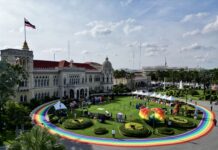
Published in the New Phytologist Trust journal on Feb. 19, a paper titled “Coordination and trade-offs among hydraulic safety, efficiency and drought avoidance traits in Amazonian rainforest canopy tree species” takes a closer look at how Amazonian tropical trees handle droughts. Conducted by a team including UC Riverside Professor of Physiological Ecology Louis S. Santiago and a team including recent Ph.D. student Mark E. De Guzman and recent UCR graduates Jacob E. Vogenberg and Max Brodie, the research revealed that Amazonian trees have a higher drought resistance than previously thought.
The Amazon rainforest has recently experienced droughts influenced by El Niño and climate change. The recent changes have caused the Amazonian trees to experience drought stress. Information on drought stress exhibited by the Amazonian tropical trees has not been documented fully, which was an obstacle the researchers faced in the beginning. However, starting in 2013, using grants from the Center for the Study of Biodiversity in Amazonia and the French government, the five-year research project collected data on the amount of rainfall reduction that causes the mortality of tree specimens, which would be incorporated to create a global circulation model.
Taking samples from tropical trees in French Guiana, a French territory in the eastern part of the Amazon rainforest, the research team analyzed the trees’ hydraulic strategies, or the plants ability to handle droughts. Using the xylem vulnerability curves, or studying the plants’ capability to move water within itself, it revealed these trees were fairly vulnerable to drought. However, when analyzing the trees through stem pressure volume curves, or the stems’ ability to retain water, it showed that the trees were more drought resistant.
“Tropical trees typically have an axial parenchymal (a long tissue that transports sugar) fraction that is three times higher than temperate trees,” stated the research paper.
Though 14 tree specimens were analyzed in the published journal, the project has continued to study more than 50 tree specimens since the publication.
While the Amazon rainforest is located in South America, it “is a major contributor to the global climate cycling … changes in the Amazonian forest can influence rain and snowfall in the west coast,” stated De Guzman.
Though the recent research reveals that the tropical trees in the Amazon rainforest are more drought tolerable than initially thought, the tropical trees are still under threat.
“If the planet keeps warming and the weather patterns keep changing, these trees will be in big trouble,” stated Santiago.
The research project is planned to end in 2019 unless further funding is received.
The team also included Christopher Baraloto from Florida International University, Bruno Herault from UMR Ecologie des forets de Guyane (UMR EcoFoG) in France, Claire Fortunel from UCLA and Damien Bonal from Universite de Lorraine in France.








